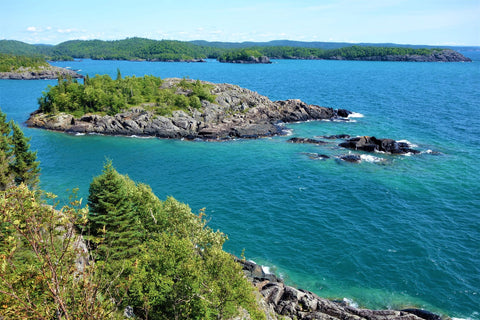
When examining the map of the Pacific Northwest region of North America, one might assume that mountains would be the most remarkable feature travelers would encounter.
But when my husband and I explored the Pacific Northwest for five weeks in July and August, I found this not to be the case.

As we camped and hiked throughout northern Idaho, Washington, and southern BC, I was much more intrigued by the pine trees, lakes, and rivers we encountered.
In my view, the mountains became more of an attractive backdrop that gave context to the landscape.
The first group of photographs pictured here were taken as we explored northern Idaho, following our travels in the high desert of Wyoming and southern Idaho in June and July.
Journeying north from Boise, we followed along the Salmon River and were thrilled to see many parties of river rafters floating in the current.

We didn't have a chance to investigate this time, but if we return to this part of the world, we will look into taking a guided rafting trip down the Salmon River.
It looked like a lot of fun, not too challenging, and the scenery was gorgeous.
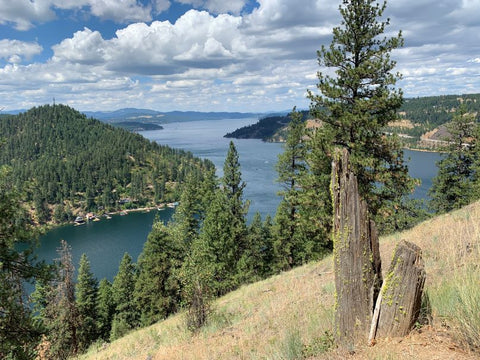
When we used to travel all over the US and Canada by motorcycle, we attended a Honda Gold Wing rally in Coeur d'Alene and were impressed by the beauty of the area.
As we planned this year's trip, we were sure to include a visit to this scenic lake, pictured here from the Mineral Ridge hiking trail.

We were thrilled to take a site seeing cruise on Lake Coeur d'Alene one warm evening. We got to know some of our fellow passengers and enjoyed excellent live music by a local band, while watching the sun go down over the surrounding hills.
It was a magical experience and the scenery reminded me of Lake Muskoka, with many luxury homes and resorts nestled along the shore.

We journeyed on from northern Idaho across Washington and up to Vancouver to visit family and friends for a week. Then we made our way south to Olympia, Washington.
For two weeks we camped at the Washington Land Yacht Harbor, an Airstream-only RV park and mobile home community.
From there, we explored the area around Tacoma. We asked a local resident about scenic hiking areas and she directed us to a hidden gem near the town of Yelm.
It was Deschutes Falls Park, a 155 acre sanctuary featuring a lovely old growth forest and a small river gorge, and we spent a pleasant afternoon hiking in this shady park.
In this photo I am standing beside one of the venerable trees beside the forest walking path.

The river water dropped 27 feet over rapids and a series of small waterfalls, interspersed with calm clear pools. All we could hear were the soothing sounds of trickling water, a breeze in the treetops, and birdsong.
The moss-covered rocks were a type of conglomerate that looked very different from the Ontario granite and limestone I am used to.
Another day, we took a bus trip to Crystal Mountain (the largest ski resort in the state of Washington) with some fellow Airstreamers. We enjoyed a gondola ride up the mountain and lunch at Summit House restaurant.
As our cable car slowly ascended, more and more of the surrounding mountain ranges came into view.

I loved seeing the progression of blue shades in the mountains, from pale cerulean in the far distance, gradually darkening to a smokey navy blue in the foreground.
You can see two gondolas in the centre of this photo.

At the summit of Crystal Mountain we enjoyed beautiful views of the Cascade Range and Mount Ranier, which we learned is pronounced ‘rah-NEER’ in Washington. (We had been calling it ‘RAY-nee-er’.)
With its snow cap glowing white in the sunshine, contrasting with the clear blue sky, Mount Ranier was an impressive sight. We also could see Mount St. Helens and Mount Baker (which we had glimpsed often when visiting Vancouver.).

Our travels then took us east through Washington, crossing back into Canada at Yahk, BC, where we found a delightful little place to stay for a few days.
River's Edge Ranch RV Park was nestled on the bank of the Moyie River, which was a shallow glacial stream with a gravel bottom.
In this photo of the campground, you can see our Airstream on the right.

The campground was just off the Crowsnest Highway and was part of a horse farm, surrounded by the Kootenay Rockies.
The owner said we could hike beside the pasture area, so we were able to stretch our legs and see the horses up close.

We drove to nearby Creston for groceries (having crossed from the USA with a nearly empty fridge) and were delighted to find many roadside stands selling local produce from vegetable farms and fruit orchards. We loaded up on organic sweet peppers, summer squash, cherries, nectarines, and apples. Delicious!
The next day we walked into the quirky village of Yahk, home of Two Pump Paul's gas station, and enjoyed lunch at a tiny ice cream shop and cafe called Two Scoops Steve's. Next door was an artisan soap shop that had a pen of pet white goats.
Between the two stores was an entrance to a public garden that lead to a charming forest walk, which eventually brought us to this beautiful spot on the Moyie River.
Our stay in this interesting community, surrounded by breathtaking natural beauty, was as delightful as it was unexpected, and allowed us to conclude our visit to the Pacific Northwest on a high note. It was time to head east towards Ontario and more adventures...
If you have comments you wish to share, please do so using the 'Leave a Comment' button at the top of this post.
Subscribe to Karen's Newsletter if you wish to see more travel tales, painting stories, studio news updates, or notices of upcoming exhibitions.



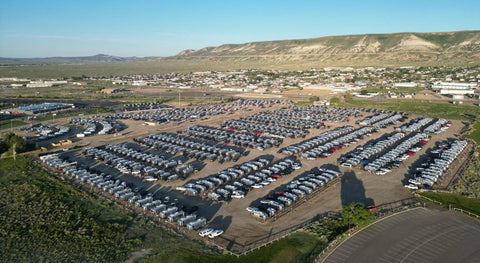



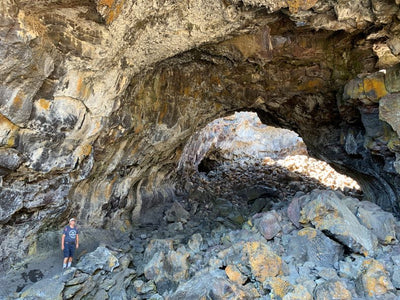























 Listen to the Silence, varnished watercolour on 14 x 11 inch panel.
Listen to the Silence, varnished watercolour on 14 x 11 inch panel.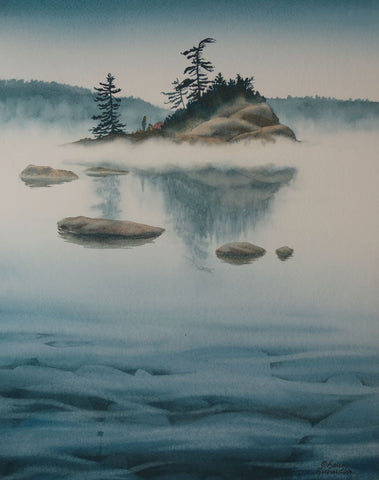

 Reunion, varnished watercolour on 10 x 10 inch panel.
Reunion, varnished watercolour on 10 x 10 inch panel. For this painting, I used her reference photo (shown here) for the foreground and invented a couple of islands to make a more interesting scene. I changed the canoe colours and decided to make the season autumn, so the trees would complement the canoes.
For this painting, I used her reference photo (shown here) for the foreground and invented a couple of islands to make a more interesting scene. I changed the canoe colours and decided to make the season autumn, so the trees would complement the canoes.

 Some Enchanted Evening, varnished watercolour on 16 x 12 inch panel.
Some Enchanted Evening, varnished watercolour on 16 x 12 inch panel. Maple Flooring, varnished watercolour on 11 x 14 inch panel.
Maple Flooring, varnished watercolour on 11 x 14 inch panel.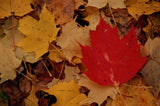





















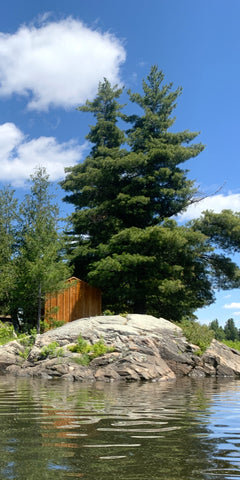

 This photo shows my husband John and me on the left, beside our longtime friends Nancy and Rick, enjoying a bit of snow shoeing at
This photo shows my husband John and me on the left, beside our longtime friends Nancy and Rick, enjoying a bit of snow shoeing at 



 In early March, we went on our second snowmobile adventure, based at
In early March, we went on our second snowmobile adventure, based at  John used a battery powered drill to auger a hole in the ice which was three feet thick. That is me in the camp chair holding a fishing rod over the hole. (No fish were harmed, or even seen, during this escapade!)
John used a battery powered drill to auger a hole in the ice which was three feet thick. That is me in the camp chair holding a fishing rod over the hole. (No fish were harmed, or even seen, during this escapade!)


 This past August, as my husband and I explored the north shore of Lake Superior with our travel trailer in tow, we had the immense good fortune to obtain a serviced camping site for a week in a most amazing place that very few people have heard about: Pukaskwa National Park.
This past August, as my husband and I explored the north shore of Lake Superior with our travel trailer in tow, we had the immense good fortune to obtain a serviced camping site for a week in a most amazing place that very few people have heard about: Pukaskwa National Park. Over the years, we had seen the sign for the turnoff to this Park on Hwy 17 between Wawa and Marathon and finally dropped in for a few hours in the summer of 2020, to check out the camping facilities.
Over the years, we had seen the sign for the turnoff to this Park on Hwy 17 between Wawa and Marathon and finally dropped in for a few hours in the summer of 2020, to check out the camping facilities.

